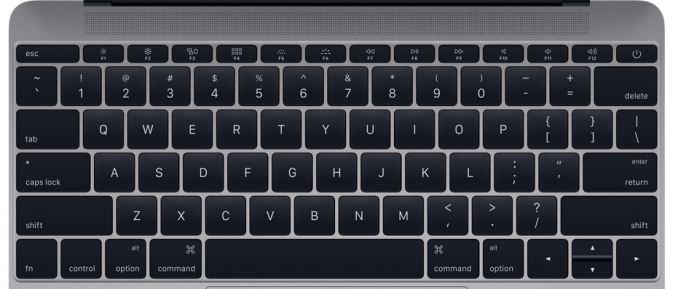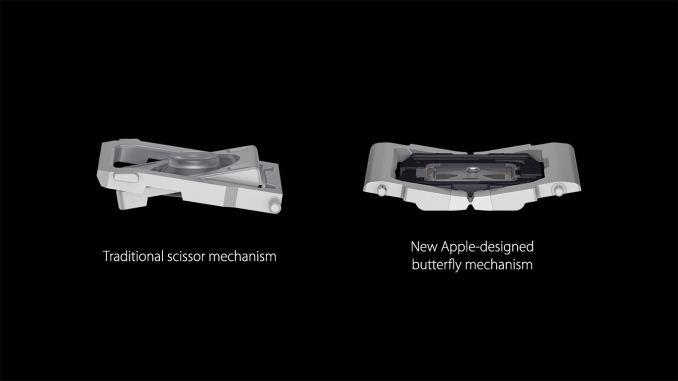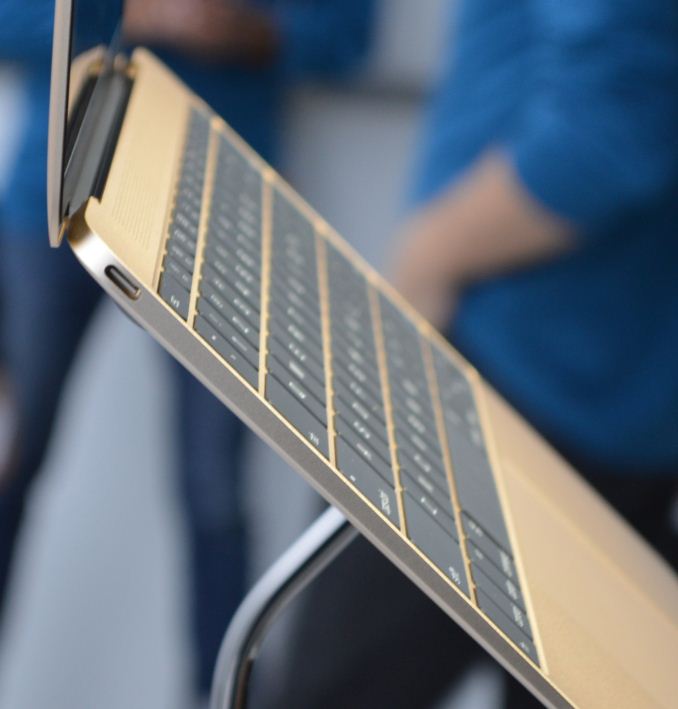The 2015 MacBook Review
by Ryan Smith on April 14, 2015 10:15 AM ESTGetting Thinner: New Keyboard, Keys, & Switches
One of the more interesting and not immediately obvious set of improvements to the MacBook come in the form of new internal mechanisms for the keyboard and trackpad. Though both look the same – and largely behave the same – as Apple’s existing products, under the hood they’ve been doing some work to improve these input devices. The driving factor of course is to further reduce the amount of Z-height these two devices take up, but there’s also a secondary focus on improving their functionality overall.
Starting with the keyboard, on the surface the MacBook implements a keyboard very similar to the now-traditional MacBook Air keyboard, incorporating a few smaller changes since their last design. Still a “full size” 78 key design that includes a top row of short function keys, Apple has made some changes to the keys themselves. Of note, the “inverted T” design of the arrow keys has been removed in favor of full size left and right arrow keys, giving the MacBook a somewhat odd arrangement where left/right are larger than up/down, rather than being identical in size as before. In Apple’s older design the space above left/right is empty space, so nothing is being sacrificed for this, but touch typists accustomed to the short arrow keys are going to have to do some adapting. Meanwhile at the other corner the escape key has been slightly elongated so that it’s wider than a normal key, and the other function keys have each been slightly narrowed to compensate.

Top: MacBook Keyboard. Bottom: MacBook Air Keyboard
Apple has also changed the overall size of the other keys, though even regular Mac users may have trouble picking up on this. The keys are now 17% larger, with Apple having slightly reduced the amount of space between each key to compensate. Meanwhile the keys are also have a deeper curve, which Apple tells us is 50% deeper. Truth be told, if not for the fact that Apple took the time to point this out in their reviewer’s guide I likely would not have picked up on either of these changes; the wider keys are noticeable once you know what to look for, but only just. Ultimately I don’t find the MacBook’s keyboard to be any different to type on as far as key size and feel goes (even with my large fingers), but your mileage may vary.

Backlit Keys: Minimal Edge Lighting
Meanwhile under the hood Apple has reworked the backlighting mechanism. The fiber optic lighting system that has been common in Apple’s designs until now has been replaced with a direct LED backlighting system, with each key having its own LED. Apple tells us that this was done for size reasons, as the direct backlighting system was smaller than the fiber optic lighting system. Not unexpectedly, this also changes how the overall backlighting system looks. The individual keys are as bright as ever – and Apple has gone so far to calibrate the LEDs to make sure they’re uniform – but with the LEDs now under the keys the amount of light around the edges of the keys has been greatly reduced. There is still some edge bleed, but now the lighting is much more focused on the symbols of the keys as opposed to lighting up the symbols and giving the keys a light border in the process.
Last but certainly not least however is the new key mechanism used underneath key, with like a number of other technologies is being first introduced on the MacBook. Apple has forgone the traditional scissor switch in favor of a newly designed mechanism they’re calling the butterfly switch, which in the slow-moving world of keyboards is the first significant change in quite some time.
The purpose of the butterfly switch is two-fold. The first of course is to reduce the size of the switch, allowing Apple to make the keyboard and resulting laptop thinner. Officially the butterfly switch is 40% thinner than Apple’s traditional scissor mechanism. That said, I’m not entirely convinced that Apple needed to switch mechanisms to reduce the keyboard thickness (though perhaps not getting 40% thinner), as we’ve seen other keyboards such as the Surface Pro 3’s type cover use some very thin scissor switches. Instead I suspect Apple’s change was focused on key stability as well.
Along with allowing for thinner keys, the other major improvement in the butterfly switch is key stability. By making the butterfly mechanism symmetrical Apple has done away with the scissor switch’s corner instability, which if pressed at a far corner would allow the scissor mechanism to actuate without actually triggering the switch. With the butterfly switch essentially composed of two identical halves that each prop up their respective corners, the instability has been eliminated as all four corners are similarly supported.
The end result, as Apple likes to pitch it, is that butterfly-backed keys are more stable and have the same feel to them no matter where on the key you press. And true to their word, in my experience this is exactly the case. The MacBook’s keys feel the same no matter where you press, and more importantly we haven’t encountered any failed keypresses in our formal or informal keyboard testing. Having used a number of scissor keyboards over the years, including a couple that suffered from non-registering corner keypresses, this is a welcome change as it’s seemingly impossible to have a key fail to register. That said the quality of scissor mechanisms definitely varies on a vendor-by-vendor basis, and with Apple’s scissor mechanism already performing well, I’m not sure if this is really all that big of a step up from other Apple designs. On the other hand what I’ve also found is that the instability problems of scissor keyboards seem to get worse as they get thinner, so it’s quite likely that Apple needed to make this change as they wouldn’t have been able to maintain their high keyboard quality with an even thinner scissor switch keyboard.
In any case, the other big change to keyboard feel is that due to the thinner switches, the total amount of key travel is significantly reduced. While the MBA and other Ultrabooks already had fairly low key travel, the MacBook’s keyboard reduces it yet again, and coupled with the changes in switches it makes the MacBook keyboard feel very different at times, and this is a difference that can take some getting used to at first. As thin as the switches are they’re closer to buttons than traveling keys – think iOS device home button – so typists accustomed to more travel and spring in their keys will immediately pick up on the difference, and I would wager take a temporary hit in words per minute (WPM) until they’ve fully adapted. After having used the MacBook for a week I can already type on it as well as I can my MacBook Pro, so it’s a relatively short adjustment period, but it’s there.
For a device of its size, overall I’d consider the MacBook’s keyboard to be an improvement over similar designs. That said, while I wouldn’t be surprised to see the backlighting improvements and key size changes eventually brought over to other MacBook designs, I don’t imagine we’ll be seeing the butterfly switch used on other, larger designs where Apple doesn’t need to be so conservative on space. As well as it works here, Apple doesn’t have the same need to deviate from the greater travel of scissor switches in their larger laptops.













354 Comments
View All Comments
TEAMSWITCHER - Friday, April 17, 2015 - link
The $1599 - 1.2GHz - 512GB model is ~5K, in Geek Bench 3.The "Actual Work" comment cracks me up. I have successfully done 3D web-plugin development for a major company on an 11" MacBook Air. I'm pretty sure I could have done the same thing with a 12" MacBook...probably even a little better.
milkod2001 - Monday, April 20, 2015 - link
3D web-plugin development could probably be done on entry level laptop :). By actual work i've meant working with many layers, exporting to high rez tiffs, pdf, a bit of video production on the go etc.This is not where new MAcbook will serve very well. That's for less then 5% of potential Macbook buyers though, so im sure many(including you) will be more then happy with this new Macbook.
vampyren - Thursday, April 16, 2015 - link
This is just a shitty laptop, underpowered, useless with one port.Apple should have added the screen, keyboard, touch-pad on Air and everyone would been happy.
There is a limit to how thin you can make things before they become useless.
I love my MBP and was going to get the updated Air had they added retina on it but they sadly made a useless version instead.
hummerchine - Thursday, April 16, 2015 - link
I'm constantly amazed at some of the fervid anti-Apple comments on this and other forums! This review was fantastic and right on...the best I've seen, and I've been seeking them out (AnandTech does a great job, as did this reviewer). The new MacBook is highly desirable for the right person...that would be me. I've ordered the best, most tricked-out model. Is it a desktop replacement? It was not intended to be! If you want a desktop with more power, or even a portable with more power...Apple and many other companies offer many other options. If you want a crazy light awesome travel computer, this is as good as it gets! The complaints about performance just blow my mind. They have crammed in the best processor, screen, keyboard, trackpad, batteries, whatever you can mention into the smallest and lightest laptop human beings can currently design. And some are whining about it? Jeez...just think about what you are saying! And if you really hate Apple's operating system so bad (my personal favorite, but I can see that is personal preference) there are competing Windows products with the same technology limitations. If you are like me and like Apple's OS, just how could they have possibly made this thing any nicer? Well...they probably could have squeezed in another USB C port or perhaps a small MagSafe connector. I suppose even more RAM might have been nice. A faster processor would be nice too...but isn't the Intel Core-M the fastest processor currently available that will fit into something so small, have good battery life, and not require a fan? Come to grips with reality some of you...that review was very accurate and well done, and I can't wait to get my new laptop! The millions of buyers of these things don't have to listen to you...they vote with their wallets! Btw, I'm very pleased to also be a stockholder.kdalkafoukis - Friday, April 17, 2015 - link
Does anybody knows any real performance details like?how many open pdfs can u have for example?
or
in which kind of programms you are gonna have problems(annoying performance)?
cgpublic - Friday, April 17, 2015 - link
I checked the new Macbook at the Apple Store. I'm a marketing professional with a a 2011 MBP 15" quad-core, 2012 MBA entry-level, and a the latest Mac Mini w/i7 dual-core in my toolkit. Apple is once again ahead of the curve, which is what they can afford to do, while other manufacturers have to design to ensure they don't leave any checkboxes unchecked. Which is why companies such as Dell are who they are, and Apple is choking on cash. People will pay good money for a taste of the future, and this is the future right here.For 95% of what I do, the Macbook Core M + good WiFi signal can manage with ease. Photo-editing can be done in a pinch w/Adobe CreativeCloud. Once you pick it up, you have to have it, and everything else is yesterday's news.
If you're primarily playing games and fapping on your PC, I guess processing power and wired connectivity is a big deal, but I earn for a living, in the real world.
tecsi - Saturday, April 18, 2015 - link
Prediction: the new MacBook will shortly outsell the 11" MBA, the 13" MBA and the 13" rMBP. Why? Dramatically better than both MBAs and priced about the same when configured with 8TB RAM and 256GB SSD. Half the weight of the rMBP, cheaper and with most of the feature set of the except for CPU speed. But for those notebook users that need performance, they will jump to 15" rMBP with its max performance.tecsi - Saturday, April 18, 2015 - link
Make that 8GB RAM, not 8TBtecsi - Saturday, April 18, 2015 - link
Two items not really clearly mentioned, but one crucial and another useful via-a-via the MBAs.First, and most important, I find I can productively use the MacBook display at 1920x1280 (with SwitchResX). This offers 266% of the screen real estate of the 11" MBA, an enormous, work-changing difference.
Second, but more minor, the new MacBook's Trackpad is ~25% bigger than the 11" MBA, providing easier, more accurate cursor movement and positioning.
jameskatt - Sunday, April 19, 2015 - link
The fact that Apple's slowest Macbook has the fastest SSD performance means the next Macbook Pro 15-inch Retina Update is going to HAVE A BLAST with huge unencumbered SSD speeds. Coupled with a 2 TB size increase and hopefully 32 GB RAM and 4K screen, this bar will move up further.